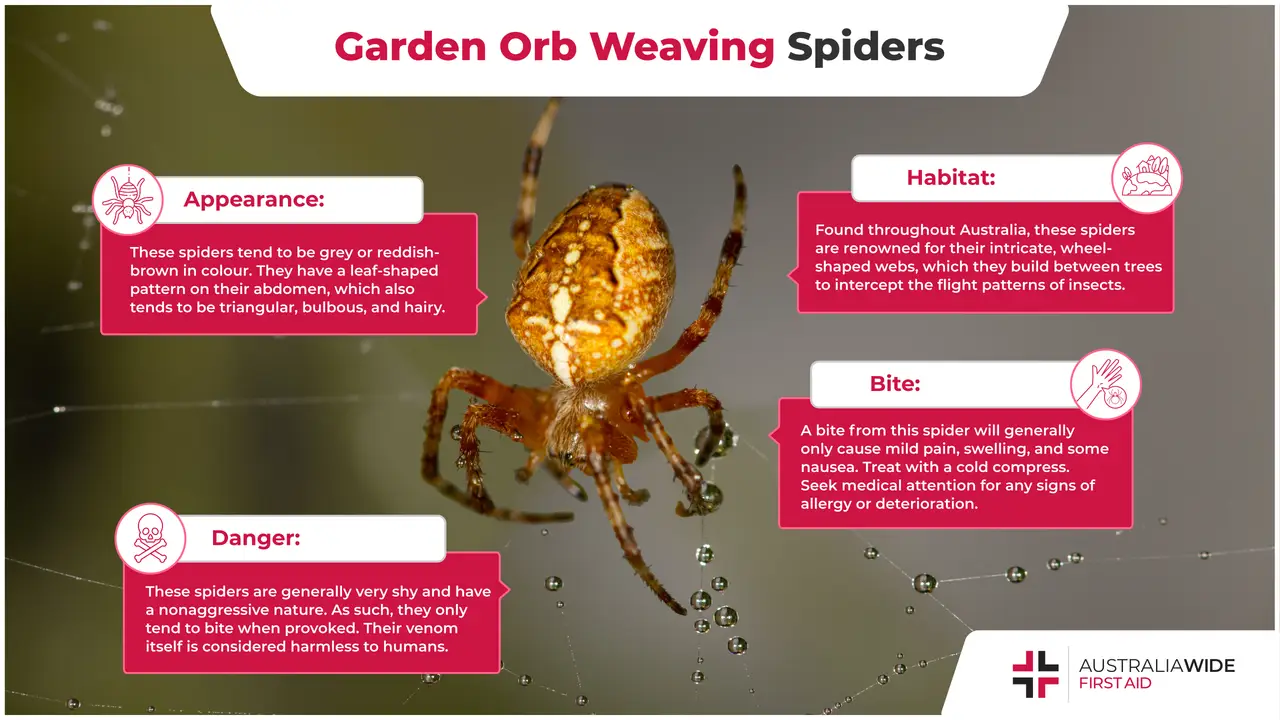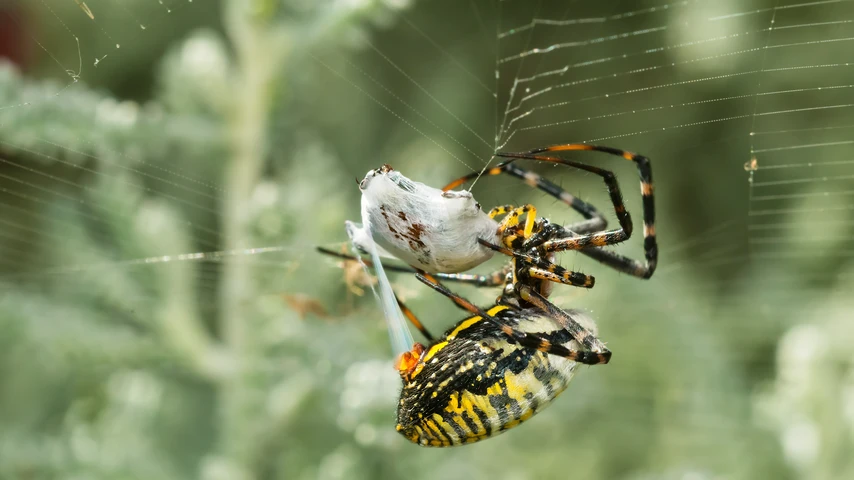Spider Facts: The Garden Orb Weaving Spider


With over 100 known species scattered across Australia, the Garden orb weaving spider is a common backyard spider in many Australian homes.
Known as ‘backyard master builders’, these hardworking spiders are renowned for their intricate ‘orb’ shaped webs that are used to catch flying insects.
Native to Australia, the garden orb weaving spider is a very common species belonging to the Araneidae family. The most common species of garden orb weaving spiders are the Eriophoria biapicata and E. transmarina from eastern and southern Australia. These spiders are known for their intricate webs that are suspended high in the air to catch flying insects by intersecting their flight patterns.
The most fascinating thing about Garden orb weaving spiders is the sheer size of their webs, which can extend from one tree to another. When building their webs, the Garden orb weaving spider will firstly find a high vantage point from which to release a steady flow of silk. Because this silk is so light, it is carried by and floats on the wind until it snags against a solid object. The spider then rinses and repeats this step until the web is strong enough to support its weight while it builds the rest of the web. Despite the hard work they put into each web, Garden orb weaving spiders remove their web at dawn each day and create another one to avoid predators during the night.
The garden orb weaving spider is present all season, though their lifespan is a mere 12 months. Female spiders tend to lay their eggs in late summer to autumn. Most often, these eggs hatch in autumn into little spiderlings that use small silk strands as ‘balloons’ to be carried off by the wind. These spiderlings then build their own tiny orb webs among shrubbery to wait out the cold weather. Finally, during the summer months, they mature into adults and begin mating and laying eggs, thus restarting the whole cycle.
Garden orb weaving spiders tend to be stout and reddish-brown or grey in colour, and they have a leaf-shaped pattern on their abdomen. As there are roughly 100 known species of Garden orb weaving spiders originating from Australia, this pattern may vary from one spider to the next. The abdomen itself is often triangular in shape and has two noticeable humps towards the front.
While all variations cannot be listed here, below is a list of common identifiers of the Garden orb weaving spider:
Garden orb weaving spiders can often be found resting in the centre of their intricate webs. Their webs are typically wheel-shaped and built between trees and shrubs, places where insects are likely to fly. When an insect gets caught in one of these wheel-shaped webs, it sends a vibration to the waiting spider. The spider then rushes towards the insect to quickly wrap it in silk, before biting it, envenomating it, and finally consuming it once dead. When food is plentiful, Garden orb weaving spiders will release any large insects that may damage their web.
Garden orb weaving spiders commonly prey on small flying insects, including flies, beetles, mosquitoes, cicadas, and dragonflies. They also like feeding on butterflies and moths – however, these insects have scales on their wings that they can shed, and so can free themselves from sticky webs. Common predators of the Garden orb weaving spider, meanwhile, includes wasp and birds – namely, honeyeaters.
Though their bites do contain venom, Garden orb weaving spiders are quite harmless to humans. They are generally very shy and have a nonaggressive nature, and so only tend to bite when provoked. Likewise, their venom has no impact on people, save for some mild pain and swelling around the bite site. Some people may also experience nausea after being bitten by a Garden orb weaving spider.

As with all spider bites, it's important to know first aid for a Garden orb weaving spider bite:
If you are worried about your symptoms, or they persist or worsen over several days, seek medical attention.
Some people can have a severe allergic reaction when bitten by a spider. This is called anaphylaxis, a condition that can be fatal in as little as 15 minutes. Symptoms include:
If the casualty begins exhibiting any of the above symptoms, call Triple Zero (000) for an ambulance, consult the Australian Resuscitation Council's anaphylaxis treatment guideline, and follow DRSABCD and prepare to perform CPR.
Common throughout the summer, Garden orb weaving spiders are abundant throughout Australia, especially in gardens.
Though their venom has relatively little impact on humans, these 'backyard master builders' are not be underestimated.
Garden orb weaving spiders can pack a mean punch - their bites have been known to cause pain, swelling, and even nausea.
If you would like to learn more about providing first aid in the event of a bite or sting, book a First Aid course with us today.
We also have articles on what to do if you get stung or bitten by snakes, fire ants, and marine life.
And for more details on how to identify and treat bites from some of Australia's deadliest spiders, including White tail spiders, Wolf spiders, Huntsman spiders, and Redback spiders, head to our Resource Library.
Disclaimer: This article is for informational purposes only. It does not constitute, replace, or qualify as any form of first aid training.

March 11, 2025
Darwin, the tropical capital of Australia’s Northern Territory, is home to a rich diversity of wildlife - including an impressive array of spiders. From the sprawling webs of golden orb-weavers to the cryptic camouflage of trapdoor spiders, these arachnids play a vital role in the local ecosystem. While some may inspire fear, the majority are harmless and even beneficial, helping to control insect populations.

September 4, 2024
Cat bites, while often underestimated, can lead to serious health complications if not treated promptly and properly. Cats' mouths harbour a variety of bacteria that can cause infections in humans.

April 1, 2024
Encounters with wildlife can often be thrilling, but when it comes to the creature known as the drop bear, the experience can quickly turn dangerous. A sharp increase in recent attacks prompts the need for understanding proper first aid procedures in case of an attack.